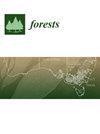The Effects of Long-Term Precipitation Exclusion on Leaf Photosynthetic Traits, Stomatal Conductance, and Water Use Efficiency in Phyllostachys edulis
IF 2.4
2区 农林科学
Q1 FORESTRY
引用次数: 0
Abstract
Ongoing climate change is projected to intensify drought stress globally. Understanding the response mechanisms of Phyllostachys edulis (Carrière) J. Houz. (moso bamboo) to long-term drought is crucial, given its significance as a carbon sequestration resource. In this study, precipitation exclusion was implemented to simulate drought stress and we investigated the effects of long-term drought on the photosynthetic parameters, stomatal conductance, and water use efficiency of moso bamboo. The results showed that throughout all growth seasons, the maximum net photosynthetic rates (Pmax) of bamboo at all ages under long-term drought conditions (after 8 years of precipitation exclusion treatment) were significantly lower than those of the control (p < 0.05). It can be concluded that long-term drought reduced the maximum photosynthetic capacity of the bamboo at all ages. Under long-term drought conditions, there were many seasons where the light saturation point (LSP) of first-degree (1–2 years old) bamboo and third-degree (5–6 years old) bamboo under drought was significantly lower than those of the control, while the LSP value of second-degree (3–4 years old) bamboo under drought was significantly higher than that of the control. This suggests that long-term drought reduced the ability of first-degree and third-degree bamboo to utilize strong light, while improving the ability of second-degree bamboo to utilize strong light in summer, autumn, and winter. Under long-term drought conditions, the light compensation point (LCP) and the apparent quantum efficiency (AQY) of the bamboo decreased. It can be concluded that long-term drought reduced the ability of first-degree bamboo to utilize weak light in all seasons, as well as the ability of second-degree bamboo to utilize weak light in spring and autumn; meanwhile, it improved the ability of second-degree bamboo to utilize weak light in summer and winter, and the ability of third-degree bamboo to utilize weak light in spring, summer, and autumn. In the high light range (PARi > 1000 µmol · m−2 · s−1), there were significant differences in stomatal conductance (gs) among different the different treatments of bamboo, which were influenced by both the growing season and the forest age. Compared to the control, under drought conditions, the stomatal conductance of third-degree bamboo increased in spring and that of the second-degree bamboo increased in autumn. The correlation analysis showed that the relationship between the stomatal conductance and vapor pressure deficit (VPDL) of bamboo under long-term drought conditions showed a significant polynomial relationship in both high and low light ranges. The correlation between the instantaneous water use efficiency (iWUE) and VPDL for the drought and control treatments of bamboo also showed a significant polynomial relationship in high light ranges. It was found that long-term drought changed the photosynthetic parameters of the bamboo, reflecting its ability to tolerate and adapt to drought in different seasons. Age-related differences in photosynthetic parameters should be fully considered in forest age structure adjustments and forest thinning procedures to strengthen the light intensity and maintain the opening of the stoma. These results provide a theoretical basis for the efficient and sustainable cultivation of bamboo under global climate change.长期降水排斥对酢浆草叶片光合性状、气孔导度和水分利用效率的影响
据预测,持续的气候变化将加剧全球的干旱压力。了解毛竹(Phyllostachys edulis (Carrière) J. Houz.(毛竹)对长期干旱的响应机制至关重要,因为它是一种重要的碳封存资源。本研究采用排除降水的方法来模拟干旱胁迫,并研究了长期干旱对毛竹光合参数、气孔导度和水分利用效率的影响。结果表明,在长期干旱条件下(经过8年的降水排斥处理),毛竹在各个生长季节的最大净光合速率(Pmax)均显著低于对照(P < 0.05)。由此可见,长期干旱降低了各年龄段竹子的最大光合能力。在长期干旱条件下,有多个季节一级竹(1-2年生)和三级竹(5-6年生)在干旱条件下的光饱和点(LSP)明显低于对照,而二级竹(3-4年生)在干旱条件下的光饱和点值明显高于对照。这说明长期干旱降低了一级竹和三级竹利用强光的能力,而提高了二级竹在夏季、秋季和冬季利用强光的能力。在长期干旱条件下,竹子的光补偿点(LCP)和表观量子效率(AQY)下降。由此可以得出结论:长期干旱降低了一级竹在所有季节利用弱光的能力,也降低了二级竹在春季和秋季利用弱光的能力;同时提高了二级竹在夏季和冬季利用弱光的能力,以及三级竹在春季、夏季和秋季利用弱光的能力。在强光范围内(PARi > 1000 µmol - m-2 - s-1),不同处理竹子的气孔导度(gs)有显著差异,这受到生长季节和林龄的影响。与对照相比,在干旱条件下,三级竹的气孔导度在春季增加,二级竹的气孔导度在秋季增加。相关分析表明,在长期干旱条件下,竹子的气孔导度与水汽压亏(VPDL)之间的关系在高光和低光范围内均呈现显著的多项式关系。干旱处理和对照处理竹子的瞬时水分利用效率(iWUE)与蒸汽压力亏缺(VPDL)之间的相关性在高光照范围内也呈现出显著的多项式关系。研究发现,长期干旱改变了竹子的光合参数,反映了竹子在不同季节对干旱的耐受和适应能力。在林龄结构调整和疏伐过程中,应充分考虑光合参数与年龄相关的差异,以加强光照强度,保持气孔的开放。这些结果为全球气候变化下竹子的高效和可持续栽培提供了理论依据。
本文章由计算机程序翻译,如有差异,请以英文原文为准。
求助全文
约1分钟内获得全文
求助全文
来源期刊

Forests
FORESTRY-
CiteScore
4.40
自引率
17.20%
发文量
1823
审稿时长
19.02 days
期刊介绍:
Forests (ISSN 1999-4907) is an international and cross-disciplinary scholarly journal of forestry and forest ecology. It publishes research papers, short communications and review papers. There is no restriction on the length of the papers. Our aim is to encourage scientists to publish their experimental and theoretical research in as much detail as possible. Full experimental and/or methodical details must be provided for research articles.
 求助内容:
求助内容: 应助结果提醒方式:
应助结果提醒方式:


